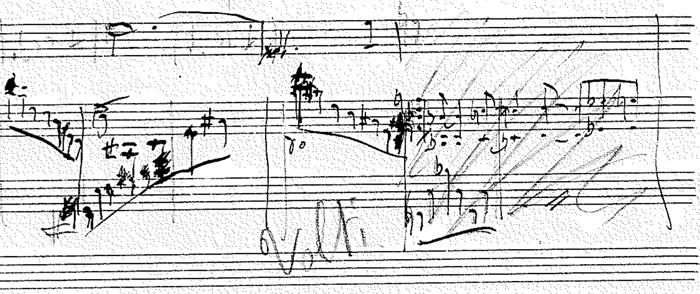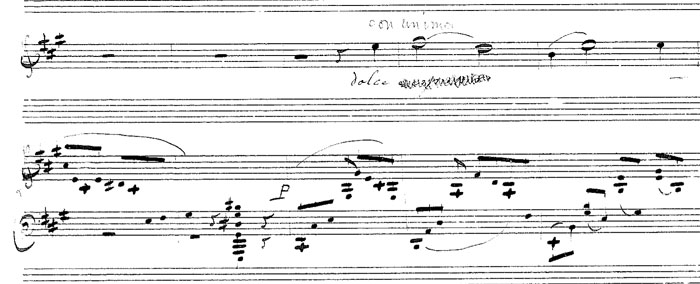Autograph manuscripts of musical works have an aura all their own that is hard to resist: They fascinate, on the one hand, by portraying a composer’s characteristic handwriting (cf. fig. 1); on the other, they give us immediate access to the composer’s workshop so long as they’re not just fair copies, but working manuscripts with corrections, deletions and additions.

The treble clef in the handwritings of various composers, from left to right: J. S. Bach, Haydn, Mozart, Beethoven, Schubert, Mendelssohn Bartholdy, Schumann, Brahms, Debussy, Ravel
The focus for Urtext editions is, of course, the autograph’s source value. So, a rough rule of thumb is that the older the work being edited, the more important the autograph manuscript. Up to the end of the 18th century only a fraction of works composed were printed during their composers’ lifetimes, and even then often without their authorization. Consequently, copies or prints are, compared with the autograph, frequently flawed, hence representing inferior sources. They contain uncorrected errors or – even worse – unauthorized interventions by the copyist or arranger. With the gradual implementation of intellectual-property copyright in the late 18th century, printing ultimately became for composers the preferred form of duplication, also establishing supervision of correct music engraving by way of galley proofs. Along with this, though, came an opportunity for the composer to make new modifications that resulted in downgrading the source value of the autograph (cf. fig. 2).
Therefore, it is not surprising that for the music of the 19th and 20th centuries the first edition as opposed to the autograph is, with exceptions, the most important source. This is generally so also for the works by Gabriel Fauré, even when we have to take into account the fact that the publications particularly of the Choudens and Hamelle publishing houses contain numerous errors as a consequence of the composer’s having been only a very superficial proof-reader.
Presenting a special case is the extant autograph for Fauré’s 1st violin sonata in A major, Op. 13 (Paris, Bibliothèque nationale de France, shelfmark: Ms. 20298). It had initially begun as a careful fair copy, but then veered off into a much revised, progressively rudimentary working manuscript, to the point that the final movement was left in a draft state. In the more elaborated portions of the manuscript two layers of revision can be distinguished: one that is taken into consideration in the first edition, together with another whose alterations are missing in print. Since Fauré, through the mediation of his friend Camille Clerc obtained publication of the new work by Breitkopf & Härtel even before the first public performance, he had had in October 1876 a now-lost, new fair copy despatched to Leipzig as engraver’s model. The publication appeared in February 1877, several weeks after the première on 27 January.
To get to the point of the conundrum shown by the autograph’s various stages of evolution, the question of which source was used for the première must be posed. Fauré’s manuscript does in fact reveal traces of performance, including a ‘Volti’ in the final movement (fig. 3), but even for experienced composers, its development appears here so incomplete that the autograph can hardly have served as model from which to play a public performance rather than merely to try out still unfinished passages.
As is known from the correspondence between Fauré and Clerc as well as Clerc and Breitkopf & Härtel, the publishing house sent the composer at his request a copy of the despatched engraver’s model – since he no longer had a copy matching the manuscript sent to Leipzig. This no longer extant copy might be taken as having been the model used in the première. Presumably all changes that arose from the ensuing proofreading in the middle of January 1877 were also entered into it.
All that is puzzling about Fauré’s manuscript is, to be sure, not in the least solved as such, but it does appear highly likely that the second layer of revision also dates from still before the production of the copy serving as new engraver’s model. Fauré himself had, after all, once more reviewed and corrected this copy and, as he wrote in a letter to Clerc, ‘added only the really essential dynamic markings’. Thus, unlike in the portions of the sonata marked in great detail, that is, in the first movement, Fauré undertook entirely deliberately a simplification that evidently also included articulation and performance markings (cf., for example, the later deletion of e espressivo to be replaced by con anima in the violin part, measure 23 of the 1st movement; dolce as well as con anima were later also omitted and replaced by a simple p).
So, for the Urtext, Fauré’s autograph, as taken into account in the new Henle edition by Fabian Kolb (HN 980), still possesses only a source value limited to erroneous passages in the first edition – though needless to say, the fascination of these manuscript remains uninfluenced by this fact.



